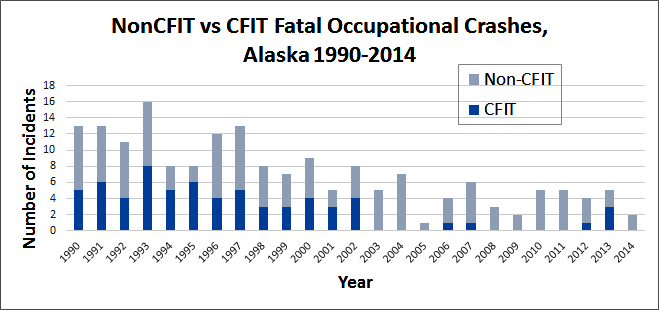Reducing Controlled Flight Into Terrain (CFIT) Accidents

N5JG Beech 95-B55 (T42A) Crash near Cantwell, June 2013. Photo: Alaska Department of Public Safety
Research showed that the most deadly aviation crashes in Alaska were due to controlled flight into terrain (CFIT), which is the act of flying an airworthy, pilot-controlled, aircraft into mountains, water, or other terrain. It often follows a departure in conditions of good visibility with continuation into conditions of limited visibility and/or poor weather, also known as visual flight rules (VFR) into instrument meteorological conditions (IMC), or VFR into IMC.
NIOSH researchers identified the risk factors associated with CFIT among air taxi and commuter (AT) pilots in Alaska during 1990–1998. Based on this and other research, the US Congress funded the Alaska Interagency Aviation Safety Initiative in 2000 to focus on improving safety in AT operations. This initiative used a multi-faceted approach to improve infrastructure, employ technology, provide education to pilots and passengers, and to encourage voluntary changes to improve safety and reduce the incidence of aircraft crashes in Alaska. Intervention strategies that were part of this initiative included:
- Medallion Program, which is a nongovernmental voluntary program for commercial air carriers that awards stars for audited achievement in five critical areas of airline safety and fosters a “culture of safety” for operators and pilots.
- Capstone Program, which improved pilots’ situational awareness and operator efficiency by providing state-of-the-art navigational equipment to provide information on weather, terrain, and other aircraft to air taxi and commuter pilots.
- The Federal Aviation Administration’s Circle of Safety is an educational program that increased safety awareness among passengers and addressed issues of potential social pressure on pilots.
- Weather cameras were placed in mountain passes and at remote airports to provide pilots with real-time weather information via the internet.
- The "Mike-in-Hand" Program provided pilots with near real-time aviation weather information via the radio.
Other NIOSH activities included research that focused on pilot survival factors in crashes through case-control studies and research on organizational risk factors through a comprehensive survey of air taxi and commuter operators and their pilots.
NIOSH researchers compared the number and rates of crashes before and after the start of the safety initiative. Of the 568 AT crashes in Alaska during 1990–2009, there was an average of 35 per year during 1990–1999 and 21 per year during 2000–2009. The number of CFIT accidents decreased from 5 per year during 1990–1999 to less than 2 per year during 2000–2009. However, CFIT crashes were almost ten times more likely to have resulted in a fatality than a nonCFIT crash.
Since 2010, four work-related CFIT crashes have occurred; continued efforts on preventing these crashes are needed. The FAA maintains a focus on CFIT prevention among commercial carriers and general aviation pilots. Pilots and air carriers must remain vigilant and continue to assess and manage risk. They should be prepared to ground a flight, reverse course, or file an instrument flight plan if weather conditions do not permit safe visual flight.

For more information on NIOSH’s efforts to reduce CFIT accidents, please read the fact sheet NIOSH Partners with Organizations and Industry to Reduce Aviation Fatalities in Alaska or the full article; A multifaceted public health approach to statewide aviation safety.
- Page last reviewed: December 30, 2016
- Page last updated: December 30, 2016
- Content source:
- National Institute for Occupational Safety and Health Office of the Director


 ShareCompartir
ShareCompartir